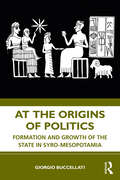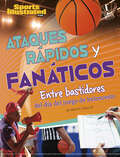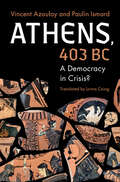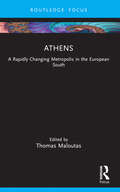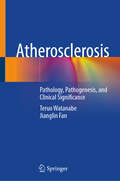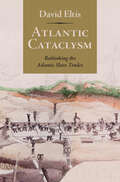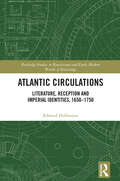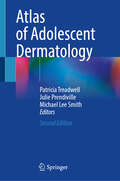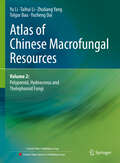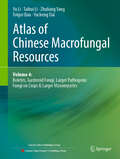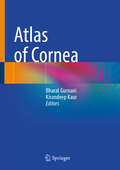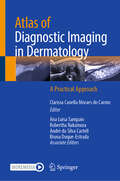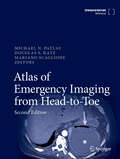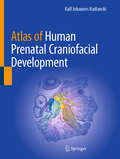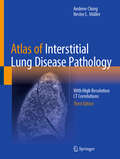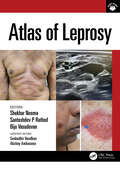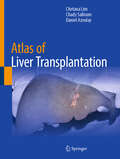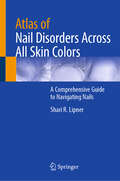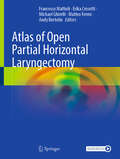- Table View
- List View
At the Origins of Politics: Formation and Growth of the State in Syro-Mesopotamia
by Giorgio BuccellatiThis volume, now available in English, explores how Mesopotamia’s urban revolution in the late fourth millennium B.C. shaped a new mentality, leading to new forms of social interaction, and to the development of the state, its laws and its religion to consolidate new managerial hierarchies in the region.How is it that the phenomenon of the state, a society structured along lines of power that frame individuals in a new supra-organism, suddenly came into being during the fourth millennium B.C.? In this book, Buccellati explores the emergence of statehood and power structures in ancient Mesopotamia against the background of the long prehistoric period. It was the arena in which the earliest cities and states were born and that offers us the first and richest documentation of the development of political life in antiquity. This book provides rich documentation of the causes that led to the formation of the territorial state, tracing its evolution from city-states to universal empires from ca 3500 B.C. to 500 B.C. At the same time, it examines the tension between individual rights and supra-personal systems of power during this period and explores new forms of social interaction that coincided with the economic dimension of the urban revolution. This paradigmatic history, newly translated into English for Anglophone readers, offers a key to understanding modern political forms and their transformations.At the Origins of Politics provides a thorough examination of the development of the state in ancient Mesopotamia, suitable for students, scholars, and researchers working on Near Eastern history and society, and ancient societies and politics more broadly.
Ataques rápidos y fanáticos: Entre bastidores del día del juego de baloncesto (Sports Illustrated Kids: día de juego)
by Martin Driscoll¿Crees que el baloncesto profesional comienza con salto entre dos inicial? ¡Piensa otra vez! En este libro de Sports Illustrated Kids, irás detrás de escena en un día de juego típico en el baloncesto profesional. Think pro basketball begins with the opening tipoff? Think again! In this Sports Illustrated Kids book, go behind the scenes of a typical game day in professional basketball.
Atavists: Stories
by Lydia MilletA Harper's Bazaar "Best Book Coming Out This Spring" Pick • One of Literary Hub's Most Anticipated Books of 2025 • One of The Millions's Most Anticipated Books of Spring 2025 A fast-moving, heartbreaking collection of short fiction from "the American writer with the funniest, wisest grasp on how we fool ourselves" (Chicago Tribune). The word atavism, coined by a botanist and popularized by a criminologist, refers to the resurfacing of a primitive evolutionary trait or urge in a modern being. This inventive collection from Lydia Millet offers overlapping tales of urges ranging from rage to jealousy to yearning—a fluent triumph of storytelling, rich in ideas and emotions both petty and grand. The titular atavists include an underachieving, bewildered young bartender; a middle-aged mother convinced her gentle son-in-law is fixated on geriatric porn; a bodybuilder with an incel’s fantasy life; an arrogant academic accused of plagiarism; and an empty-nester dad determined to host refugees in a tiny house in his backyard. As they pick away at the splitting seams in American culture, Millet’s characters shimmer with the sense of powerlessness we share in an era of mass overwhelm. A beautician in a waxing salon faces a sudden resurgence of grief in the midst of a bikini Brazilian; a couple sets up a camera to find out who’s been slipping homophobic letters into their mailbox; a jilted urban planner stalks a man she met on a dating app. In its rich warp and weft of humiliations and human error, Atavists returns to the trenchant, playful social commentary that made A Children’s Bible a runaway hit. In these stories sharp observations of middle-class mores and sanctimony give way to moments of raw exposure and longing: Atavists performs an uncanny fictional magic, full of revelation but also hilarious, unpretentious, and warm.
Athens, 403 BC: A Democracy in Crisis? (Classical Scholarship in Translation)
by Vincent Azoulay Paulin IsmardAt the end of the fifth century BC, the Peloponnesian War resulted in Athens' shattering defeat by Sparta. Taking advantage of the debacle, a commission of thirty Athenians abolished the democratic institutions that for a century had governed the political life of the city and precipitated a year-long civil war. By autumn 403 BC, democracy was restored. Inspired by the model of the ancient chorus, this strikingly innovative book interprets a crucial moment in classical history through the prism of ten remarkable individuals and the shifting groups which formed around them. The former include more familiar names like the multifaceted Sokrates, the oligarch Kritias and the rhetorician Lysias, but also lesser-known figures like the scribe Nikomachos, the former slave Gerys and the priestess Lysimakhe. What leads a community to tear itself apart, even disintegrate, then rebuild itself? This question, explored through profound reflection on the past, echoes our tormented present.
Athens: A Rapidly Changing Metropolis in the European South (Built Environment City Studies)
by Thomas MaloutasThis book looks at the current trends in Athens, the capital city of Greece, and focuses on the processes of globalization it has been undergoing during the last two decades. In this time the city has transformed from a low-key, petty bourgeois cohesive and rather isolated city in south-eastern Europe to an internationally visible metropolis, increasingly unequal and polarized.The book mainly deals with changes in the social structure and the ways that different groups are linked to the city’s built environment. The main issues discussed in the book include the economic identity and the position of Athens in the regional and global urban networks; the reproduction of class and ethnic boundaries and the uneven distribution of different social groups in urban space; the exploration of political processes related to the class vote, including the gender and demographic profile of the city’s electorate; the making of the built environment, the main trends in real estate and the ways they affect the housing market. Athens is not abundantly discussed in the urban studies literature, even though social and spatial changes have been remarkable. As such, this book provides a concise overview of the main socioeconomic and spatial changes in Athens during the last two decades and their significance beyond the case of Athens.This book will be of interest to researchers and students of the built environment, urban studies and urban sociology.
Atherosclerosis: Pathology, Pathogenesis, and Clinical Significance
by Jianglin Fan Teruo WatanabeThis book covers all aspects of atherosclerosis from human pathology to experimental studies, from basic science to clinical applications. It comprises 20 chapters including human pathology of human atherosclerosis, cellular biology of atherosclerosis (endothelial cells, smooth muscle cells, monocyte/macrophages, dendritic cells and so on), molecular biology of lipid metabolism and hyperlipidemia, pathophysiology of acute coronary syndrome, plaque vulnerability and plaque rupture, aortic aneurysms, peripheral atherosclerosis. The chapters begin with the history of atherosclerosis followed by different &“hypotheses&” regarding atherosclerosis. Through these introductions, readers can learn the state-of-the-art information from human pathological observations to basic research, from experimental animal studies to clinical practice. The book includes more than 100 color pictures along with schematic illustrations. An effort has been made to show real pathological observations with clinical implications side by side. This book not only helps researchers and clinicians understand the molecular basis of atherosclerosis, but also guides them to explore the unknown questions based on the experience of the authors. It also serves as a useful reference for medical students interested in learning about cardiovascular diseases or those planning to participate in atherosclerosis research.
Athlete Is Agender: True Stories of LGBTQ+ People in Sports
by Nicole Melleby Jess Vosseteig Katherine Locke and Nicole MellebyAthlete is agender. Athlete can mean anyone. "Part memoir, part manifesto" (Booklist) this book revels in the achievements of strong, passionate, and determined LGBTQ+ athletes across every age, level, and field of sports. Find your strength in: Adam Rippon&’s unbelievable journey from figure-skating Olympic alternate to the first openly gay Olympic medalist in his sport; CeCé Telfer&’s career as a trans track star and her unwavering commitment to run for the future freedom of trans athletes; em dickson&’s relationship to eir gender identity and how sailing, a sport that doesn&’t categorize athletes by gender, helped em embrace eir power and identity, and many other invaluable true stories. Featuring testimonies by world-class athletes and award-winning children&’s book authors, as well as profiles on culture-defining figures like Megan Rapinoe and Billie Jean King, Athlete Is Agender is a lifesaving book not to be missed. This book is for: · LGBTQIA+ kids, teens, tweens, and adults · Athletes and sports fans · Readers looking to learn more about the LGBTQIA+ community · Parents of gay kids and other LGBTQIA+ youth · Educators looking for advice about the LGBTQIA+ community TITLE IX UPDATE Laws are constantly being debated, repealed, and fought for. On January 9th, 2025, a federal court in Kentucky argued that transgender and nonbinary students should not be covered by Title IX protections, rolling back the 2021 order from then-Secretary of Education Miguel Cardona. Right now, schools are currently required to follow the old version of Title IX, which does not include a section on transgender athletes. It's up to us to keep pushing to get those protections back for transgender students. For transgender athletes reading this, the most powerful thing you can do is to be true to yourself, stay informed, and be sure to vote in every election you are eligible for. ★ A Junior Library Guild Selection
Atisa's Stages of the Path to Awakening: Together with Commentaries and Ritual Texts
by James B. AppleThis book contains a lost Stages of the Path (Lamrim) work composed by the originator of the genre, Atisa, one of the greatest Indian Buddhist masters to ever set foot in Tibet.Nearly a millennium ago, the great Indian Buddhist master Atisa Dipamkarasrijñana (ca. 982–1054) wrote a guidebook for realizing all the stages to awakening at the repeated request of his closest Tibetan disciple. Atisa is famously the author of the Lamp for the Path to Awakening (Bodhipathapradipa), a short work in verse, but this longer prose work has been virtually unknown, even in Tibet—until now. Atisa&’s Stages of the Path Awakening (Bodhipathakrama), translated here, synthesizes all aspects of Buddhist practice, from the very beginning of the path—reflecting on the fortunate opportunity of human rebirth—up through to attaining omniscient buddhahood by nondual meditation. The Indian master&’s faithful disciple Dromtönpa kept these teachings secret, and they were only transmitted to select disciples in a closely guarded transmission, but the lineage died out centuries ago, after Dromtönpa&’s Kadam school was eclipsed by history. Now this significant work of Buddhist path literature has become available owing to recently recovered manuscripts of the Kadampas. This book offers a study and complete translation from the Tibetan of this monument of guidance on the Buddhist path accompanied by the commentaries and ritual texts that were transmitted alongside Atisa&’s text. Apple&’s substantial introduction includes a structural comparison with Atisa&’s famous work, charts the transmission lineage for the present work before it died out, and explores various hypotheses for why their fates diverged. Recovered from the contingencies of history, this book brings to life one of the most holistic and integrated approaches to the highest realizations of the Indian Buddhist path ever transmitted in Tibet.
Atlantic Cataclysm: Rethinking the Atlantic Slave Trades
by David EltisIn this comprehensive work, David Eltis offers a two-thousand-year perspective on the trafficking of people, and boldly intervenes in the expansive discussions about slavery in the last half-century. Using new and underexplored data made available by slavevoyages.org, Eltis offers compelling explanations of why the slave trades began and why they ended, and in the process debunks long-held assumptions, including how bilateral rather than triangular voyages were the norm, and how the Portuguese rather than the British were the leading slave traders. Eltis argues that two-thirds of all enslaved people ended up in the Iberian Americas, where exports were most valuable throughout the slave trade era, and not in the Caribbean or the US. Tracing the mass involvement of people in the slave trade business from all parts of the Atlantic World, Eltis also examines the agency of Africans and their experiences in the aftermath of liberation.
Atlantic Circulations: Literature, Reception and Imperial Identities, 1650-1750 (Routledge Studies in Renaissance and Early Modern Worlds of Knowledge)
by Edward HolbertonAtlantic Circulations investigates literary conversations about empire in the British Atlantic world, c. 1650–1750. Reading texts by Anne Bradstreet, John Milton, Daniel Defoe, and Benjamin Franklin, as well as writing by overlooked authors who deserve more attention, such as the Quaker anti-slavery activist Benjamin Lay and the Black classicist Francis Williams, it asks how literary culture interacted with transatlantic debates about law, enslavement, economics, and religious freedom.This study explores the relationship between literature and empire by joining up disciplinary areas – Early Modern English Literature and Early American Literature – which are often considered apart. It develops insights and analytical frameworks from recent British and ‘Atlantic World’ history to argue that the transatlantic reception of literary texts was often shaped by ‘archipelagic’ dynamics: political and religious tensions between and within England and Wales, and Scotland and Ireland. Atlantic Circulations examines several previously unknown manuscripts and archives which throw new light on the circulation of literary texts in colonial culture and reconstructs key Anglophone transatlantic cultural debates during a crucial phase of European expansion in the Atlantic world.This book will appeal to advanced students and academic researchers of early modern and eighteenth-century English literature and British cultural history, especially readers with an interest in literature’s relationships with empire, colonialism, and travel, and scholars of early American literature and history.
Atlas of Adolescent Dermatology
by Patricia Treadwell Michael Lee Smith Julie PrendivilleThe field of adolescent dermatology is a growing topic amongst pediatricians and adolescent medicine providers. There are numerous conditions specific to the adolescent population that require specialized care. This book details the diagnosis and management of a variety of adolescent skin diseases. The text is organized into eight different sections. The first section describes the most common conditions seen in the adolescent population, acne and perioral dermatitis. Sections two and three cover cutaneous infections and infestations and eczematous papulosquamous issues. The fourth section focuses on autoimmune and rheumatologic conditions while part five provides reactions to external causes. The final three sections detail genodermatoses and genetic conditions in dermatology, tumors and nodular lesions and lymphocytic disorders. Since publication of the previous edition, there have been several important developments in the field. One major issue that was not addressed is skin cancer in adolescents. Due to tanning beds and other factors, the prevalence of skin cancer in adolescents is rising. Various diagnoses and managements are addressed. Infections from body art such as tattoos and piercings is also a hot topic that has been added. The number of youths getting tattoos and piercings has also risen and subsequently so have complications from them. Now fully revised and expanded. The Atlas of Adolescent Dermatology is a valuable resource for dermatologists, adolescent medicine specialists, family medicine practitioners, and primary care physicians.
Atlas of Chinese Macrofungal Resources: Volume 2: Polyporoid, Hydnaceous and Thelephoroid Fungi
by Yu Li Taihui Li Zhuliang Yang Tolgor Bau Yucheng DaiThis book is part of the 4-volumes collection of Atlas of Chinese Macrofungal Resources. This atlas documented 1819 species (or varieties) in 509 genera of macrofungi known from China, which are, according to their morphological characteristics, practically divided into 10 groups, including 196 larger ascomycetes, 21 jelly fungi, 47 coral fungi, 637 polyporoid, hydnaceous and lephoroid fungi, 11 cantharelloid fungi, 653 agarics, 130 boletes, 75 gasteroid fungi, 16 larger pathogenic fungi on crops, and 33 larger myxomycetes. All species are evidenced with vouchers and photographs. About 370 of the listed species (occupying 1/5 of the total species) have their type localities in China, among which over 260 species (accounting for 1/7 of the species) were firstly discovered and published by the present authors. Some of the species are endemic to China and East Asia. Descriptions of all species are accompanied with color photographs showing their macro-morphology and (or) habitat. The macroscopic and microscopic diagnostic characters, ecological habits, economic importance (edibility, medicinal availability or toxicity) and geographical distribution in China of all species are described in brief and easy-to-understand style. In the guide, the characteristics and using method of the book, related mycological vocabulary, common taxonomic techniques and positions of the fungal genera in modern taxonomic system are briefly introduced. The knowledge of this book should be interesting to mycologists, mycology fans and mushroom lovers, as well as researchers, teachers and students studying on edible fungi, plant pathology, healthcare and biomedicine sciences, bioresources and biodiversity, ecology and other related disciplines. It is an ideal reference for those who are interested in the Chinese macrofungi and larger slime molds. In this second volume, it covers Polyporoid, Hydnaceous and Thelephoroid Fungi.
Atlas of Chinese Macrofungal Resources: Volume 3: Cantharelloid Fungi & Agarics
by Yu Li Taihui Li Zhuliang Yang Tolgor Bau Yucheng DaiThis book is part of the 4-volumes collection of Atlas of Chinese Macrofungal Resources. This atlas documented 1819 species (or varieties) in 509 genera of macrofungi known from China, which are, according to their morphological characteristics, practically divided into 10 groups, including 196 larger ascomycetes, 21 jelly fungi, 47 coral fungi, 637 polyporoid, hydnaceous and lephoroid fungi, 11 cantharelloid fungi, 653 agarics, 130 boletes, 75 gasteroid fungi, 16 larger pathogenic fungi on crops, and 33 larger myxomycetes. All species are evidenced with vouchers and photographs. About 370 of the listed species (occupying 1/5 of the total species) have their type localities in China, among which over 260 species (accounting for 1/7 of the species) were firstly discovered and published by the present authors. Some of the species are endemic to China and East Asia. Descriptions of all species are accompanied with color photographs showing their macro-morphology and (or) habitat. The macroscopic and microscopic diagnostic characters, ecological habits, economic importance (edibility, medicinal availability or toxicity) and geographical distribution in China of all species are described in brief and easy-to-understand style. In the guide, the characteristics and using method of the book, related mycological vocabulary, common taxonomic techniques and positions of the fungal genera in modern taxonomic system are briefly introduced. The knowledge of this book should be interesting to mycologists, mycology fans and mushroom lovers, as well as researchers, teachers and students studying on edible fungi, plant pathology, healthcare and biomedicine sciences, bioresources and biodiversity, ecology and other related disciplines. It is an ideal reference for those who are interested in the Chinese macrofungi and larger slime molds. In this third volume, it covers Cantharelloid fungi & Agarics.
Atlas of Chinese Macrofungal Resources: Volume 4: Boletes, Gasteroid Fungi, Larger Pathogenic Fungi on Crops & Larger Myxomycetes
by Yu Li Taihui Li Zhuliang Yang Tolgor Bau Yucheng DaiThis book is part of the 4-volumes collection of Atlas of Chinese Macrofungal Resources. This atlas documented 1819 species (or varieties) in 509 genera of macrofungi known from China, which are, according to their morphological characteristics, practically divided into 10 groups, including 196 larger ascomycetes, 21 jelly fungi, 47 coral fungi, 637 polyporoid, hydnaceous and lephoroid fungi, 11 cantharelloid fungi, 653 agarics, 130 boletes, 75 gasteroid fungi, 16 larger pathogenic fungi on crops, and 33 larger myxomycetes. All species are evidenced with vouchers and photographs. About 370 of the listed species (occupying 1/5 of the total species) have their type localities in China, among which over 260 species (accounting for 1/7 of the species) were firstly discovered and published by the present authors. Some of the species are endemic to China and East Asia. Descriptions of all species are accompanied with color photographs showing their macro-morphology and (or) habitat. The macroscopic and microscopic diagnostic characters, ecological habits, economic importance (edibility, medicinal availability or toxicity) and geographical distribution in China of all species are described in brief and easy-to-understand style. In the guide, the characteristics and using method of the book, related mycological vocabulary, common taxonomic techniques and positions of the fungal genera in modern taxonomic system are briefly introduced. The knowledge of this book should be interesting to mycologists, mycology fans and mushroom lovers, as well as researchers, teachers and students studying on edible fungi, plant pathology, healthcare and biomedicine sciences, bioresources and biodiversity, ecology and other related disciplines. It is an ideal reference for those who are interested in the Chinese macrofungi and larger slime molds. In this fourth volume, it covers Boletes, Gasteroid fungi, Larger pathogenic fungi on crops & Larger myxomycetes.
Atlas of Cornea
by Bharat Gurnani Kirandeep KaurThis atlas provides an overview of corneal pathologies. It includes over 300 images of several corneal pathologies in daily clinical practice. It provides a comprehensive overview of corneal pathologies by senior cornea experts across the globe. The chapters offer guidance on numerous corneal pathologies such as microbial keratitis, corneal ectasia, keratoconus, dry eyes, ocular corneal trauma, refractive surgery, keratoconjunctivitis, ocular surface disorders, limbal stem cell deficiency, pterygium, ocular surface squamous neoplasia (OSSN), pinguecula, degenerations, dystrophies, conjunctivitis, etc. The book guides ophthalmologists in practice and training for diagnosing corneal pathologies.
Atlas of Diagnosis and Management of Breast Disease
by Ismail Jatoi Edited By John R. Benson Dorin DumitruThis atlas focuses on the principles of diagnosis and management of breast diseases with a target audience of trainees and junior consultants in gynaecology, together with SAS grade doctors, advanced care practitioners, and specialist nurses.Key Features: Provides an expert guide to the range of breast problems presenting for the gynaecologist Offers a reliable summary of the possible diagnoses and follow-up management procedures involved Guides the front-line clinician with the information to manage and advise patients with confidence
Atlas of Diagnostic Imaging in Dermatology: A Practical Approach
by Clarissa Canella Moraes do CarmoDermatologic ultrasonography is an important method, being essential for diagnosing pathologic conditions. However, diagnostic imaging in dermatology goes far beyond ultrasonography. Other image modalities are also available such as radiography, computed tomography, magnetic resonance imaging using surface coil with specific sequences. These techniques allow for 3D imaging reconstructions, which can be used to create 3D-printed anatomical models, and support biomodeling for detailed anatomical analysis and surgical planning. This book intends to guide dermatologists and radiologists to dermatologic radiological imaging. For each lesion it describes: Epidemiology, Clinical presentation, Histopathology, Radiological signs on radiography, computed tomography, ultrasonography and MRI, where applicable. All images are accompanied by schematics and illustrations. It also includes 3D imaging reconstructions and videos for further clarity.
Atlas of Emergency Imaging from Head-to-Toe
by Mariano Scaglione Douglas S. Katz Michael N. PatlasThis new reference work provides a comprehensive and modern approach to the imaging of numerous non-traumatic and traumatic emergency conditions affecting the human body. It reviews the latest imaging techniques, related clinical literature, and appropriateness criteria/guidelines, while also discussing current controversies in the imaging of acutely ill patients. The first chapters outline an evidence-based approach to imaging interpretation for patients with acute non-traumatic and traumatic conditions, explain the role of Artificial Intelligence in emergency radiology, and offer guidance on when to consult an interventional radiologist in vascular as well as non-vascular emergencies. The next chapters describe specific applications of Ultrasound, Magnetic Resonance Imaging, radiography, Multi-Detector Computed Tomography (MDCT), and Dual-Energy Computed Tomography for the imaging of common and less common acute brain, spine, thoracic, abdominal, pelvic and musculoskeletal conditions, including the unique challenges of imaging pregnant, bariatric and pediatric patients. There are two new sections for 2nd edition. One section is devoted to imaging of emergency conditions in geriatric patients. The second section covers special considerations in emergency imaging including imaging of intimate partner violence and emergencies in transplant patients. Written by a group of leading North American and European Emergency and Trauma Radiology experts, this book will be of value to emergency and general radiologists, to emergency department physicians and related personnel, to obstetricians and gynecologists, to general and trauma surgeons, as well as trainees in all of these specialties.
Atlas of Human Prenatal Craniofacial Development
by Ralf Johannes RadlanskiThis comprehensive atlas captures the prenatal formation of the human head with precision and detail, helping the reader discover the intricate world of craniofacial development. It serves as both a rich visual reference and a foundation for further research on how molecular signaling shapes the unique features of the craniofacial structure. Authored by a leading researcher with more than four decades in prenatal morphogenesis, this atlas goes beyond existing texts by offering an in-depth look at embryonic head formation through high-quality histology and advanced 3D reconstructions. More than 400 meticulously curated, vivid color images include detailed illustrations and 3D models that trace each crucial stage in the development of the human head's anatomical structures. An invaluable resource for scientists, medical professionals, educators, and anyone studying human development, the Atlas of Human Prenatal Craniofacial Development provides insights that lay the groundwork for understanding not only human morphology but also the roots of congenital anomalies.
Atlas of Inherited Retinal Diseases (Advances in Experimental Medicine and Biology #1467)
by Stephen H. Tsang Tarun Sharma Vlad DiaconitaThis atlas provides a thorough overview of various inherited retinal dystrophies with an emphasis on phenotype characteristics and how they relate to the most frequently encountered genes. It also meets the previously unmet needs of PhD students who will benefit from seeing the phenotypes of genes they work on and study. Further, because genetic-testing costs are quite high and spiraling higher, this atlas will help geneticists familiarize themselves with the candidate gene approach to test patients’ genomes, enabling more cost-efficient testing. This invaluable atlas is organized into eight sections starting with an introduction to the basic knowledge on retinal imaging, followed by diseases listed according to inheritance pattern and disorders with extraocular manifestations grouped by defining features. This structure will be intuitive to clinicians and students studying inherited retinal disorders. In this thoroughly updated new edition featuring new images and the latest research developments, new chapters on the history taking of IRD suspect patients. Updated chapters on mimics of IRD diseases, as well as a novel section on current available treatments.
Atlas of Interstitial Lung Disease Pathology: With High Resolution CT Correlations
by Andrew Churg Nestor L. MüllerThis objective of this atlas is to serve as an updated diagnostic resource that allows pathologists to diagnose interstitial lung disease (ILD) when they encounter it in biopsies. Pathologists often struggle in this area due to the numerous different and sometimes overlapping entities encompassed by term &“ILD&”. ILD pathology is unique in that diagnostic accuracy always requires correlation with the clinical and particularly the radiologic findings. This is different from most areas of pathology in which only minimal clinical/radiologic information will allow an accurate diagnosis. By including CT findings, pathologists will know what to look for in radiology reports or when talking with radiologists. A further recent development has been the increasingly widespread use of transbronchial cryobiopsy for diagnosing interstitial lung disease. What is becoming evident, however, is that there is astonishingly little in the way of pathologic guidance for making diagnoses with cryobiopsies, and pathologists struggle with them. Advances in understanding the genetics of ILD have led to realization that there are major overlaps in the genetic abnormalities associated with a UIP pattern, even if the underlying disease is fibrotic hypersensitivity pneumonitis or connective tissue disease. A new idea is that of telomeropathy; i.e. the finding that patients with short telomeres are particularly likely to develop fibrotic lung disease, and, most importantly, should not be treated with immunosuppressive agents. Atlas of Interstitial Lung Disease: Pathology with High Resolution CT Correlations 3rd Edition is primarily directed toward non-expert pathologists who encounter interstitial lung disease specimens, as well as radiologists who want some understanding of the pathologic basis for the imaging findings. The book incorporates current clinical/radiological/pathologic guidelines and provides information on how to apply them to biopsy specimens.
Atlas of Leprosy
by Shekhar Neema Biju Vasudevan Santoshdev P Rathod Senkadhir Vendhan Akshay AmbasanaAtlas of Leprosy comprehensively covers the varied manifestations, including common and uncommon presentations, of leprosy, supported by patient photographs and additional video content, to assist medical practitioners diagnose leprosy in the early stages.With a detailed guide to approaching bedside diagnostic tests, this book will help readers to visualise common and uncommon presentations of leprosy, enabling effective diagnosis and treatment in this pre-elimination era, where increasingly difficulties in identifying its early stages can lead to preventable morbidity and deformity.Clinicians, dermatologists and trainees alike will find the wealth of high-quality illustrations and video demonstrations a vital guide to better diagnose this mycobacterial disease and combat resistance, relapse, reactions and any other difficult challenges posed.
Atlas of Liver Transplantation
by Daniel Azoulay Chetana Lim Chady SalloumThe Atlas of Liver Transplantation presents the principles and techniques of liver transplantation in a vividly illustrated, easy-to-understand format. Its primary objective is to portray common situations in liver transplantation: from graft harvesting to explantation of the native liver, portocaval anastomosis to biliary anastomosis. Featuring more than 350 color photographs organized into thirteen chapters, Atlas of Liver Transplantation is designed to be equally useful for students, surgical residents, trainees, surgeons seeking current evidence-based information in subspecialty areas relevant to their general surgical practice, and leading experts in the field.
Atlas of Nail Disorders Across All Skin Colors: A Comprehensive Guide to Navigating Nails
by Shari R. LipnerThis atlas encompasses the spectrum of nail disorders and intends to provide an up-to-date and highly illustrated synopsis of both common and rare conditions. The diseases included are of infectious, inflammatory, neoplastic, and traumatic etiologies, and include both adult and pediatric conditions. There is an emphasis on images spanning a range of Fitzpatrick skin types, to demonstrate the similarities and differences in presentation of nail diseases in light, medium, and dark skin. Atlas of Nail Disorders Across All Skin Colors is not only an important tool for dermatologists in practice or in training but also for physicians in fields such as internal medicine, primary care, pediatrics, and surgery who often see patients with nail conditions as part of their day-to-day practice.
Atlas of Open Partial Horizontal Laryngectomy
by Francesco Mattioli Erika Crosetti Michael Ghirelli Matteo Fermi Andy BertolinThis atlas is designed to offer a comprehensive and step-by-step guidance on Open Partial Horizontal Laryngectomies (OPHLs). Thanks to these surgical procedures, a functional portion of larynx can be preserved, and the patient can maintain voice and swallowing function. Besides the detailed description of the surgical techniques, the book covers the post-operative care, the management of complications and the dysfunctional operated larynx. Enriched with high-definition illustrations, the work enables the reader to understand the key aspect of this complex surgery and to use it in surgical settings or during dissection courses. Written by a team of renowned experts in the field, this Atlas of Open Partial Horizontal Laryngectomy is a unique and invaluable practical resource for ENT surgeons who want to understand when and how these procedures should be performed.
